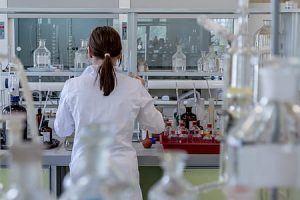Do you work in a lab, or fast food? Surprisingly, these two industries have a lot in common when it comes to single use plastic. We recently completed a net zero pathway for a client and learned a lot about single use labware in the process. Admittedly, it’s a bit niche, but we thought it was so interesting that we wanted to tell you about it. After all, this kind of thinking can be applied to many industries (like food retail) and is relevant to everyone when we are considering alternatives to single-use plastic. Read on…
 Over the last few decades many science laboratories have become reliant on disposable single use plastics to conduct their research and testing. In 2014, scientists from Exeter University estimated that their bioscience department (280 bench scientists) was generating up to 267 tonnes of plastic waste per year. Extrapolating their laboratory’s plastic waste to cover all the biological, medical, and agricultural science laboratories worldwide equates to around 5.5 million tonnes of plastic waste every year. Some of the plastic waste is recycled, but the majority goes to landfill or is incinerated (ideally in a waste to energy plant).
Over the last few decades many science laboratories have become reliant on disposable single use plastics to conduct their research and testing. In 2014, scientists from Exeter University estimated that their bioscience department (280 bench scientists) was generating up to 267 tonnes of plastic waste per year. Extrapolating their laboratory’s plastic waste to cover all the biological, medical, and agricultural science laboratories worldwide equates to around 5.5 million tonnes of plastic waste every year. Some of the plastic waste is recycled, but the majority goes to landfill or is incinerated (ideally in a waste to energy plant).
Regardless of how the waste is disposed, the biggest source of carbon emissions from these products is the primary production and manufacture of the products themselves. Addressing the carbon footprint of single use laboratory consumables will be an important factor to consider for research institutions when making commitments to emissions reduction and net zero pathways.
Prior to the uptake of single use plastic, reusable glass labware was commonplace, and a return to reusable glass or plastic labware is being considered in many laboratories. Glass labware is generally more expensive than reusable plastic, but it is also more resistant to corrosive substances, heat, and scratches resulting in a longer usable lifespan. Reusable plastic has the advantage of being less fragile and more lightweight. Reusing labware reduces consumption and waste, however, requires cleaning, decontamination and sterilisation which subsequently increases chemical, water, and energy use, and requires additional equipment and staff time. Consideration also needs to be given to the effect that reusable labware may have on the reproducibility of experiments, reagents that may have been optimised for use on plastics (e.g. cell culture medium), and the availability of suitable reusable options to replace the wide variety of single use plastic labware available.
The environmental impact of reusable items compared to single use is best determined through a Life Cycle Analysis (LCA). LCA analysis of single use products versus reusables vary, with some LCAs suggesting reusables do not have significant environmental benefits over single use, although these often depend on the assumptions made around the number of reuses, the washing protocol, and weighting of environmental metrics. When considering the impact on GHG emissions, water, and waste, replacing single use items with reusable items (washed in an efficient manner) was found to be environmentally beneficial, with only around a third of the emissions and water use of single use products.

Multiple LCA studies have looked at kitchenware and products associated with the food service industry. The single use products and their reusable replacements have some similarity to the materials and products for lab use. A 2021 review of multiple LCAs concluded that reusable food service ware was better than single use in almost all measures. This included single use products made of all types of materials and not just plastic. They also found the cost of reusables (including labour costs) was less than for single use products.
A 2023 report is the first published study comparing the CO2-e impact and running costs of four reusable versus single use laboratory consumables. The footprints included production, washing, autoclaving, drying, and disposal calculations. Around 99% of the total footprint of single-use items was production related, highlighting the emissions benefit of simply using less (i.e. reusing items), compared to the impact of washing and drying these items.
So, whether you work in a lab or in a food outlet, there is scientific evidence to support that reusables are not only better for the environment, reducing production emissions and virgin material use, but also better for the bottom line. If you are trying to reduce your carbon emissions to achieve net zero, then you really should consider reusables in your daily processes. If you want to know more about our single-use plastic research, or if you are considering a net zero pathway for your organisation, contact us on info@tandem.energy
